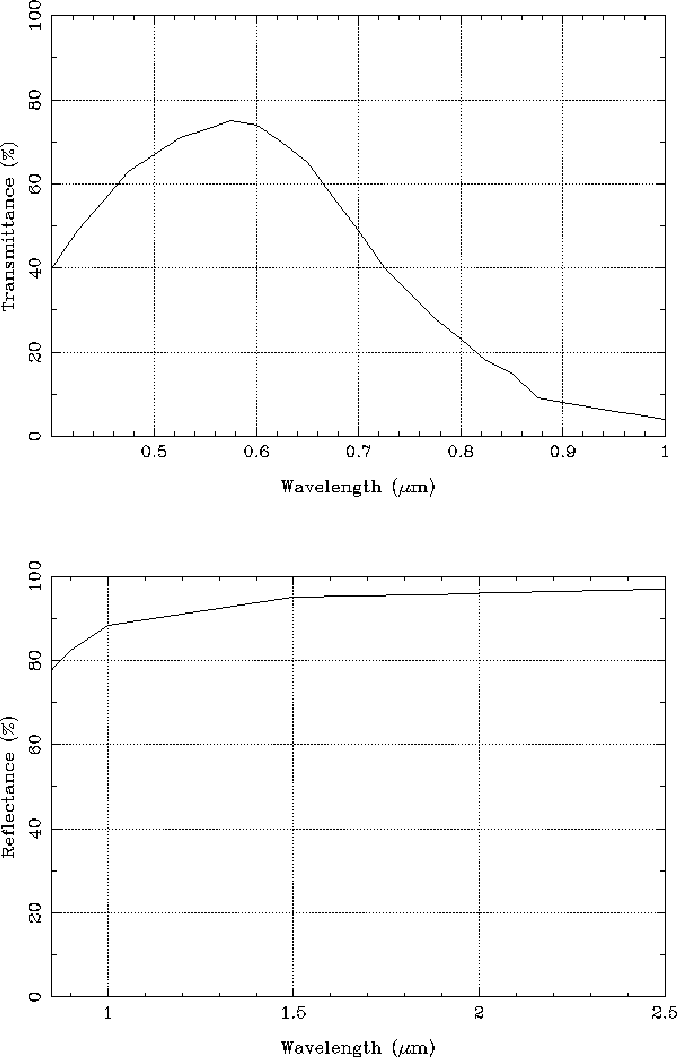The detector is a Santa Barbara Research Corporation (SBRC) InSb array enclosed in the old UKIRT IRCAM-1 cryostat. The internal optics were designed by Eli Atad (ROE), and consists of a doublet (the fore-optics), which collimates an expanding f/11 beam, two filter wheels, and an f/6.2 triplet that re-images the collimated beam onto the array.
The detector is cooled to 30K by a closed-cycle high pressure He cooling
system, consisting of a vibrationally isolated heat pump mounted on top
of the cryostat, connected to a compressor in the oil pump room on the
ground floor by ![]() 60 m of high pressure stainless steel piping.
The triplet lense and filters are also cooled, to
60 m of high pressure stainless steel piping.
The triplet lense and filters are also cooled, to ![]() 70 K, with the doublet
probably a little warmer, as it sits in an extended snout.
70 K, with the doublet
probably a little warmer, as it sits in an extended snout.
The InSb detector currently installed is serial number FPA40348, and has the following characteristics:
Although the detector
is sensitive over the wavelength range 0.8-5.5 ![]() m, the WHT is not
optimised for the IR (in particular, it doesn't have a chopping secondary,
the secondary is oversized with respect to the primary beam, plus the central
obstruction and the baffles on the
chimney and secondary are seen by the beam), so that most
imaging will be restricted to 0.8 - 2.3
m, the WHT is not
optimised for the IR (in particular, it doesn't have a chopping secondary,
the secondary is oversized with respect to the primary beam, plus the central
obstruction and the baffles on the
chimney and secondary are seen by the beam), so that most
imaging will be restricted to 0.8 - 2.3 ![]() m (i.e. J to Ks).
m (i.e. J to Ks).
The total throughputs (includes sky absorption, all optical surfaces,
lens and filter absorption, and detector quantum efficiency) are
![]() 16% for J, 17% for H and 17% for Ks
(this is for GHRIL, which has an
all-reflecting image de-rotator, thus adding an extra 3 reflections.
There are plans to mount WHIRCAM at Cassegrain Auxiliary Port, which should
give higher throughput, plus the use of the offset guider, but
this probably won't be ready until after semester 96B).
16% for J, 17% for H and 17% for Ks
(this is for GHRIL, which has an
all-reflecting image de-rotator, thus adding an extra 3 reflections.
There are plans to mount WHIRCAM at Cassegrain Auxiliary Port, which should
give higher throughput, plus the use of the offset guider, but
this probably won't be ready until after semester 96B).
There are a number of known bad (i.e. dead and permanently hot) pixels on the array (see Figure 2), the main feature being a few bad columns between pixel positions (55, 81) and (54, 256). The brightest of these are recorded in a bad pixel map, and are masked off for display purposes (see § 3.5.1), but the frames are written to disk unmasked.

Figure 2: The location of the main hot pixels.
The readout/detector control is a virtual copy of the Array Limited Infrared Control Environment (ALICE) rack built for UKIRT's IRCAM-3 and CGS-4, which is controlled by a DEC VAXstation 4000 via Ethernet. The chip can also be continuously displayed via 3 coax cables to an RGB monitor. Control software is a copy of UKIRT's IRCAM-3, except for the stepping motor controllers (two filter wheels and one focus) and the telescope interface (for writing coords, etc to the headers).
Normally WHIRCAM sits on its own optical breadboard at the GHRIL Nasmyth
focus (Figure 1). At GHRIL, the beam passes through an
all-reflecting (silver plus MgF coated)
image de-rotator to an optically flat dichroic, which reflects most of
the light
longward of 0.9 ![]() m, and transmits the optical light
(Figure 3) to
an optical CCD autoguider, via an f/6 re-imaging lens. The CCD autoguider
has a field of view of 52''(NS)
m, and transmits the optical light
(Figure 3) to
an optical CCD autoguider, via an f/6 re-imaging lens. The CCD autoguider
has a field of view of 52''(NS) ![]() 70''(EW) (but is vignetted
beyond a diameter of 40''), a scale of
0.2''/pix, and a limiting magnitude of
70''(EW) (but is vignetted
beyond a diameter of 40''), a scale of
0.2''/pix, and a limiting magnitude of
![]() 17 mag in V for an integration time of
17 mag in V for an integration time of ![]() 4 sec (this is for a
typical full moon sky brightness and 0.8'' seeing, but it will of course
vary depending on the sky brightness and seeing). The centre of the WHIRCAM
field lies at a position (230, 180) on the Autoguider CCD (ie is not centred).
4 sec (this is for a
typical full moon sky brightness and 0.8'' seeing, but it will of course
vary depending on the sky brightness and seeing). The centre of the WHIRCAM
field lies at a position (230, 180) on the Autoguider CCD (ie is not centred).

Figure 3: Dichroic's transmission (upper) and reflectance (bottom) curves.